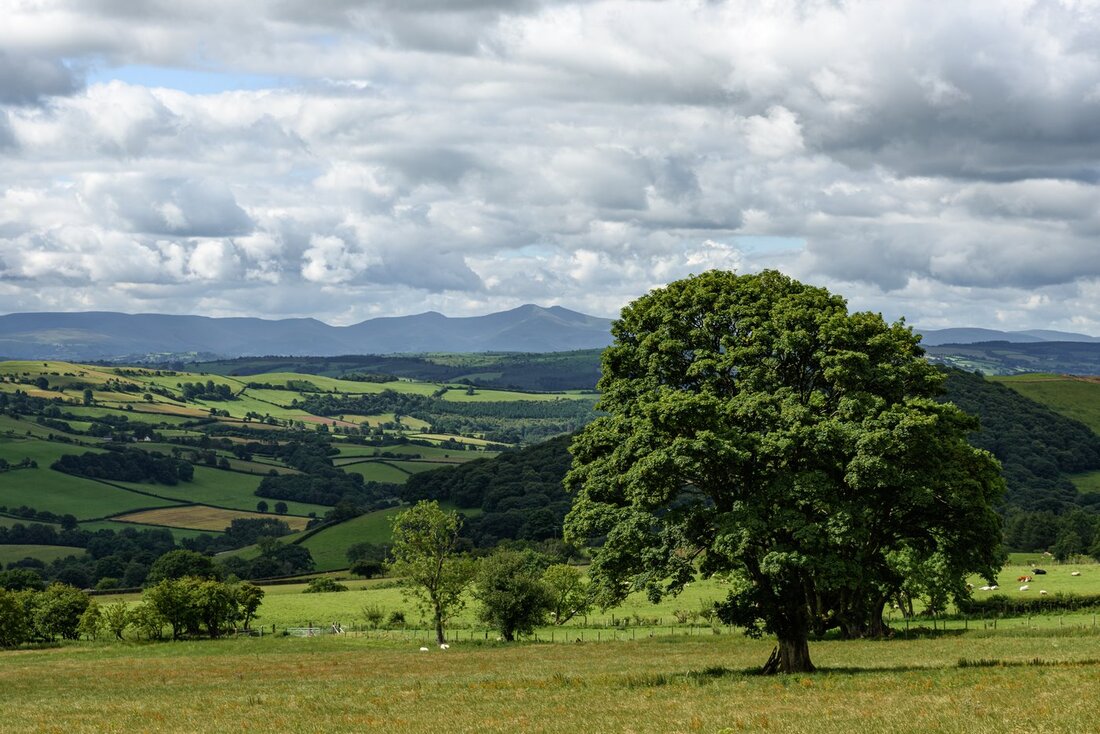Whilst most assuredly a proud, Welsh community and formerly a very significant part of the ancient county of Radnorshire, now subsumed within the larger county of Powys, Painscastle and Rhosgoch are undoubtedly characterised by their central position within the Welsh Borders or Marches – the English border and the county of Herefordshire are just over 5 miles away across the River Wye to the South-East.
The small villages of Painscastle and Rhosgoch, together with the much smaller, outlying settlements of Bryngwyn, Llanbedr and Llandeilo Graban, form an upland community of just over 500 persons, many of whom also live in the scattered farmsteads to be found along the Bachawy river valley that links these different settlements and also much higher up on the significant moorland ridge that comprises Llandeilo Hill, Llanbedr Hill, Red Hill and Bryngwyn Hill.
This is an area rich in history in which much of the landscape has remained largely unchanged since the Normans arrived in the 11th century and built their first motte and bailey fortification at Painscastle in about 1130. The subsequent centuries were largely dominated by open warfare between the Welsh and the Normans/English and between the so-called Marcher Lords and the English Kings.
In between these conflicts the local population worked to tame the wild and often hostile moorland and boggy valley terrain and to create a sound, agricultural base on which the community economy could prosper. However, even until the 20th century land ownership was largely based on a ruling nobility that had mainly inherited its wealth from the Norman Conquerors and the many adventures of their descendants.
After the ravages of the Middle Ages the original, historic community of Llanbedr Painscastle prospered mainly from its considerable success in agriculture and from its importance to the annual movement of livestock from Welsh pastures to the more lucrative markets in England. The community found itself on one of the main, so-called drover’s routes that saw literally thousands of cattle, sheep, pigs and even some birds being driven for much of the year along the various lanes through the area by the Welsh and English equivalent of the cowboy. The village of Painscastle became a town in which all manner of services could be provided to the drovers - for a price.
The advent of the railways in the 19th century brought an end to the drovers and the people of Painscastle and Rhosgoch finally settled down to their ultimate destiny as a quiet but close-knit community largely dependent on the dominant agricultural business of keeping sheep, but also some cattle and now increasingly poultry. However, not all of its inhabitants are directly or indirectly involved in that sector and the community is now changing rapidly to reflect the very different demands of the 21st century.
The small villages of Painscastle and Rhosgoch, together with the much smaller, outlying settlements of Bryngwyn, Llanbedr and Llandeilo Graban, form an upland community of just over 500 persons, many of whom also live in the scattered farmsteads to be found along the Bachawy river valley that links these different settlements and also much higher up on the significant moorland ridge that comprises Llandeilo Hill, Llanbedr Hill, Red Hill and Bryngwyn Hill.
This is an area rich in history in which much of the landscape has remained largely unchanged since the Normans arrived in the 11th century and built their first motte and bailey fortification at Painscastle in about 1130. The subsequent centuries were largely dominated by open warfare between the Welsh and the Normans/English and between the so-called Marcher Lords and the English Kings.
In between these conflicts the local population worked to tame the wild and often hostile moorland and boggy valley terrain and to create a sound, agricultural base on which the community economy could prosper. However, even until the 20th century land ownership was largely based on a ruling nobility that had mainly inherited its wealth from the Norman Conquerors and the many adventures of their descendants.
After the ravages of the Middle Ages the original, historic community of Llanbedr Painscastle prospered mainly from its considerable success in agriculture and from its importance to the annual movement of livestock from Welsh pastures to the more lucrative markets in England. The community found itself on one of the main, so-called drover’s routes that saw literally thousands of cattle, sheep, pigs and even some birds being driven for much of the year along the various lanes through the area by the Welsh and English equivalent of the cowboy. The village of Painscastle became a town in which all manner of services could be provided to the drovers - for a price.
The advent of the railways in the 19th century brought an end to the drovers and the people of Painscastle and Rhosgoch finally settled down to their ultimate destiny as a quiet but close-knit community largely dependent on the dominant agricultural business of keeping sheep, but also some cattle and now increasingly poultry. However, not all of its inhabitants are directly or indirectly involved in that sector and the community is now changing rapidly to reflect the very different demands of the 21st century.
